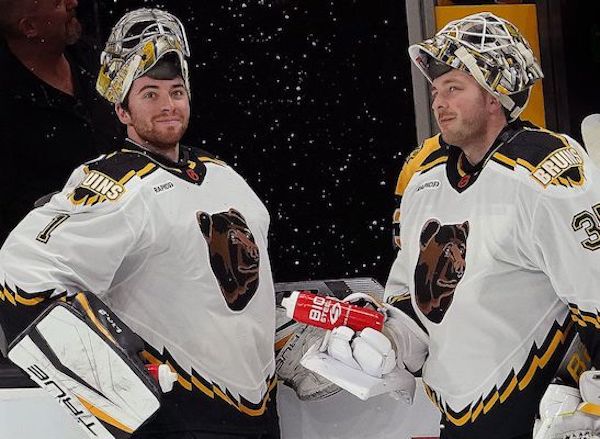
By: Pierce Brody | Follow me on Twitter @PierceBrody3
The Bruins stumbled onto a dominant goalie tandem in the last two years. Linus Ullmark and Jeremy Swayman both built on career years last year for one of the most convincing Jennings trophy candidacies in recent memory. Yet, all good things must come to an end, as the bill for the pair will come due soon. Swayman is due for a raise in restricted free agency, Ullmark is only under contract for two more years himself, and the Bruins seem to have another goalie prospect coming of age in Brandon Bussi.
As there are no apparent signs of the front office breaking the pair, we should consider what has come of other dominant tandems in the modern era. When looking through the other duos, a spectrum seemed to arise where there were pairs with gaudy statistics, pairs with a prospect nipping at the heels of his partner, and a blend of the two.
The National Hockey League postseason continues, and if you want to get in on the action, check out these Stanley Cup 2023 odds and futures. FanDuel Sportsbook is the world’s most trusted sports wagering company that is safe and secure with fast payouts.
In the 2000’s Detroit employed an older superstar goalie room of Dominik Hasek and Chris Osgood. Bruins fans remember all too well the years split between Tuukka Rask and Tim Thomas. Similarly, it is easy for Bruins fans to forget how dominant Roberto Luongo was. He’s often remembered for being chased in the 2011 Stanley Cup Final for the young, well-regarded Cory Schneider.
Finally, I came across two forgettable combinations with surprisingly dominant statistics. Jaroslav Halak with Brian Elliott, a set of journeymen who caught fire in St. Louis one year in the early 2010s. Additionally, Thomas Greiss with Robin Lehner, another pair of journeymen whose careers have gone in opposite directions since their stint for the Islanders.
Clearly, all of these contract situations and future outlooks are different than what the Bruins are dealing with. However, it doesn’t hurt to see what symmetry exists and if it can help prophesize what the Bruins situation will end with.
Hasek and Osgood are much older than Ullmark and Swayman. Hasek retired after only four disjointed years in Detroit, and Osgood finished up his long career only three seasons later. Safe to say, this is not very illuminating.
Thomas and Rask jostled for position for years in Boston before Thomas began to decline, and Rask truly became a top-flight goaltender. Thomas eventually stepped away from hockey, and the Bruins dumped his hefty contract for essentially no return. He tried to stage a comeback in the 2013-2014 season before retiring for good. Thomas was in his late 30s when he began his decline, so it’s unlikely either current Bruin will replicate that unless this year was a one-hit-wonder.
Luongo had a highly successful career in Vancouver and Florida. His prime years were spent backstopping the Sedins’ Canucks. Then there was the highly regarded prospect in Schneider, who made his presence known by replacing Luongo as the starter in multiple playoff runs and at the beginning of the 2012 regular season.
Shockingly, Schneider was traded, not Luongo. Schneider went on to be an above-average starter for a few seasons before severely underperforming the last few years in New Jersey. The Devils sent the ninth selection in the draft, which turned into Bo Horvat. This should be taken with a grain of salt as Horvat overperformed his draft position.
This situation is much closer to the Bruins’. However, unlike with Vancouver, we have no indication of trade interest, and while Swayman is similar to Schneider, Ullmark does not have the pedigree of Luongo.
Finally, we come to the journeyman duos. Ullmark may not have been on as many teams as the other four; his rise to stardom after years of mediocrity is all too similar. Only Halak is similar to Swayman, who had been up and down to start his young career.
Lehner has been relatively successful subsequently but somewhat derailed by injuries. Halak’s and Elliott’s success caused them to bounce around as up-and-down starters for a few years before settling into their career role as higher-end backups. Greiss survived as a starter for two more years before returning to his career-long role as a backup.
When he was on an expiring contract, Lehner fetched the Blackhawks a second-round pick, a low-level prospect, and our old friend Malcolm Subban. After a few up-and-down subsequent seasons as a starter, Elliott was sent to Calgary for a second and conditional third-round pick.
He played poorly before being relegated to backup duty in Philadelphia two seasons later. Greiss was allowed to walk as a free agent just one unceremonious season later. Halak was flipped as a part of the Ryan Miller trade to St. Louis. Halaks play had diminished his value so much that he was eventually sent to the Islanders for just a fourth-round pick.
These scenarios of peak and valley feel a bit more likely for Ullmark. Yet, none of these journeymen had quite the season that the Bruins’ backstop did. Perhaps the Lehner trade gives perspective on what value Ullmark holds. Still, Ullmark’s likely Vezina trophy and an extra year on his contract add immense value.
Truly, these situations are not similar enough to tell much more beyond what value the Bruins pair might hold. We’ll have to wait and see what the front office decides and whether these goalies are in for illustrious careers or the lives of journeymen.


Leave a Reply